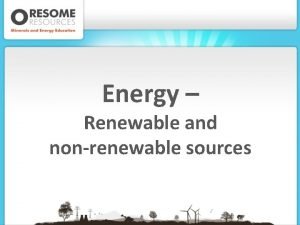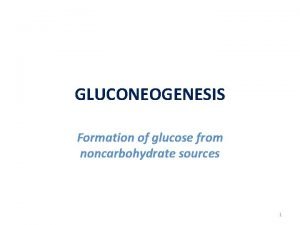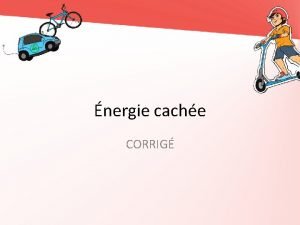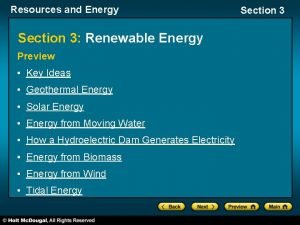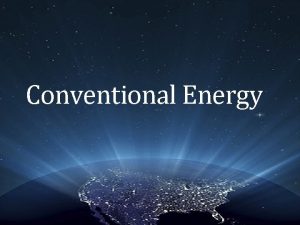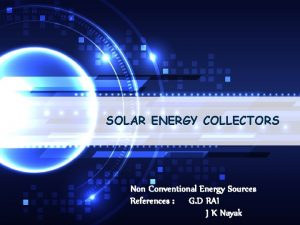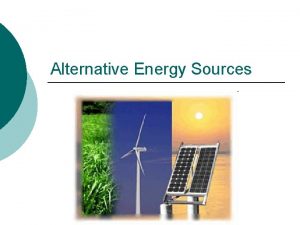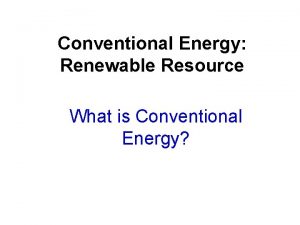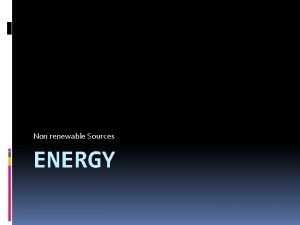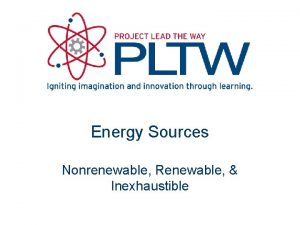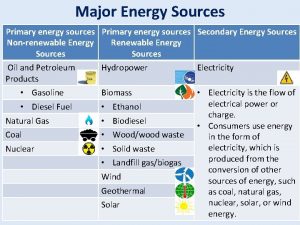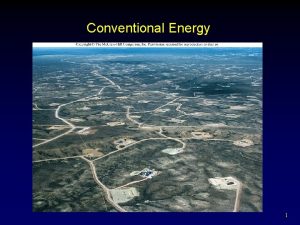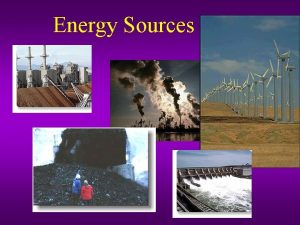A Presentation ON NON CONVENTIONAL ENERGY SOURCES PRESENTED















- Slides: 15

A Presentation ON “NON CONVENTIONAL ENERGY SOURCES” PRESENTED BY NEELAM ROY ROLL NO : 24 UNIVERSITY BT & EVENING COLLEGE Session 2013 -2014

INTRODUCTION q Energy is basically the capacity of a body to do work. q The different forms of energy are: Mechanical energy, Thermal (or) Heat energy, Chemical energy, Electrical energy, Nuclear energy, Electromagnetic energy, Gravitational energy. q The S. I unit of energy is Joule. q There are 2 types of energy sources: conventional energy sources and non conventional energy sources.

Cont… q Conventional energy sources include fossil fuel energy and nuclear energy. q It is a non renewable source of energy. q Non conventional energy sources include wind energy, tidal energy, solar energy, bio energy & fuel cell energy. q It is renewable source of energy.

SOLAR ENERGY q The energy that is produced from sun is known as solar energy. q The Sun’s energy comes from nuclear fusion reaction that takes place deep in the sun, where hydrogen nucleus fuse into helium nucleus. q When such a reaction takes place then tremendous amount of energy is produced which is escaped into the space. q About 15% of sun’s energy is absorbed by earth’s atmosphere, some part is absorbed by earth’s surface and rest is reflected back to space.

Solar radiation v. We can not use 100% solar energy to electricity by solar cell. v 51% of solar energy reaches to earth. v Different atmosphere absorbed as well as reflect some amount of solar radiation. v The incident energy in the cross section of the cell is converted only. v Only 10 -12% we can use.

Use of solar energy for domestic purposes: - Fig (1) solar cooker

Solar energy as a source of power generation: Photovoltaic Solar Power

Wind Energy q Wind energy has potential to be used as a source of power q Wind power is harnessed by setting up a wind mill which is used for pumping water , generating electricity etc q This can be judged from the fact that energy available in the wind over the earth’s surface is estimated to be 1. 6 x 107 K. W q And the energy available is free and clean.


BIO GAS ENERGY q Bio gas is generated through a process of anaerobic degradation of Bio Mass. q Bio Mass is organic matter produced by plants, both terrestrial (those grown on land) and aquatic (those grown in water) and their derivatives. q It includes forest crops and residues, crops grown especially for their energy content on “energy farms” and animal manure. qsolar energy –>Photosynthesis –> Bio Mass->energy generation

Use of bio gas energy for domestic purposes: -

TIDAL ENERGY q Tide is periodic rise and fall of the water level of the sea. q This rise and fall of water level occurs due to the attraction of sea water by the moon. q When the water is above the mean sea level, it is called flood tide and when the level is below the mean level, it is called ebb tide. q These tides can be used to produce electrical power which is known as tidal power.

Tidal energy as a source of electricity generation: - Fig (a) Fig (b) v Recently A Canadian Tidal Energy Technology Company has signed an Agreement with Alstom Hydro for production of electricity through tidal energy.

CONCLUSION Ø Ø Non conventional sources of energy are abundant in nature These are renewable resources These are pollution free and eco friendly So NON CONVENTIONAL SOURCES OF ENERGY is valuable as it will meet the energy needs in future, as conventional sources of energy is going to exhaust in future and these sources of energy are also harming the environment directly or indirectly

THANK YOU
 Non renweable resources
Non renweable resources Print and web sources
Print and web sources Importance of water
Importance of water Veux-tu briser du péché le pouvoir lyrics
Veux-tu briser du péché le pouvoir lyrics Non conventional solutions
Non conventional solutions Hypdro
Hypdro Energy energy transfer and general energy analysis
Energy energy transfer and general energy analysis Energy energy transfer and general energy analysis
Energy energy transfer and general energy analysis Glycogenolysis youtube
Glycogenolysis youtube Glucose synthesis from non-carbohydrate sources
Glucose synthesis from non-carbohydrate sources Pyruvate to acetyl coa
Pyruvate to acetyl coa Glucose synthesis from non-carbohydrate sources
Glucose synthesis from non-carbohydrate sources Les sources d'énergie non renouvelable
Les sources d'énergie non renouvelable Section 3 renewable energy sources worksheet answers
Section 3 renewable energy sources worksheet answers Green energy concept
Green energy concept Nonrenewable energy sources
Nonrenewable energy sources
